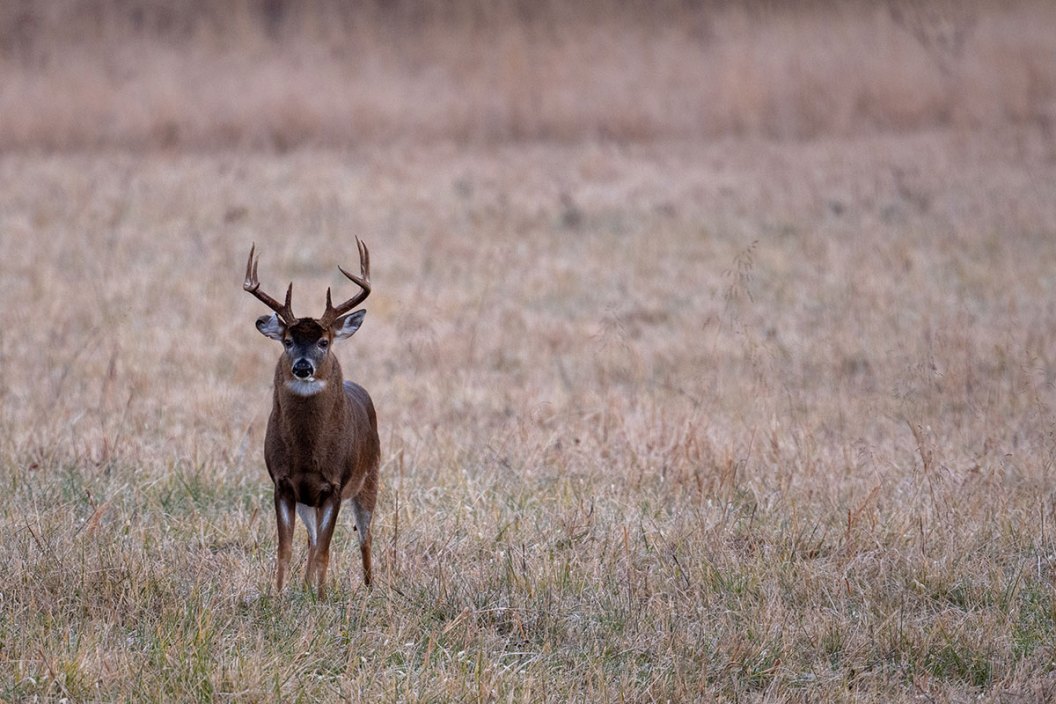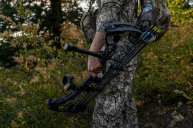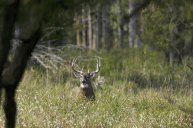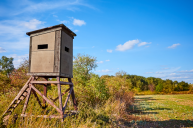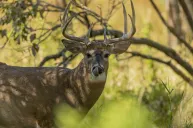What will you do when these deer hunting temptations present themselves?
We've said it before: no sportsmen have to self-regulate like hunters do. Often we are on our own in the woods or on the water, and we have no authority figure before us except our own good judgement.
This is not to say that we have to choose only between game regulations that are on the books and whatever it is we would like to do, but that there are other circumstances that come up as well.
Now don't get things twisted. We aren't talking about taking one extra buck or doe over the limit, or shooting across the property line into your neighbor's land. We intend to bring up things that happen all too often and need to be looked at a little more closely, but not illegal. If we bring things up that don't fit within your areas regulation, well what do you think we're going to advise?
Be smart, but also consider these predicaments we might all eventually face in our hunting careers.
Here are some suggestions and thought provoking situations that we all go through at one time or another.
Shooting a Young Buck
Remember, we are not saying that you cannot shoot a young whitetail buck, that you should not take a young buck, or that it is in any way wrong to do so. This is a simple reminder of why letting young bucks walk can affect the future in your deer hunting area.
Any time that you see a spike buck or a fork horn, it is almost certainly an 18-month-old deer. This means that exactly one year before you encountered this young buck from your stand, it was a fawn. It hasn't bred with a doe and won't during that fall mating season.
One of the reasons that so many hunters see these young deer up close is that they are curious, inexperienced, and honestly a little dumb to the dangers of the world around them.
It is quite true that many youth hunters take a spike or a fork horn their first year hunting. In many cases, that is the strongest memory of their hunting lifetime. They almost always present an easy shot for a young hunter: they're less educated, more curious, and sometimes seems like they're looking right at them in their final moments.
For a youth hunter just starting out, it's almost inarguable. This is the kind of thing that they won't ever forget. But for a veteran hunter, it's important to ask the right questions before pulling the trigger. Could he become a wall hanger in the future, if you just gave him a few more years? Could he become a mature buck that breeds many does and keeps the local deer population viable by spreading his genes? Are you diminishing the herd by harvesting a potential stud?
The fact remains; shooting young bucks takes deer out of the population that the herd arguably needs. The ideals behind quality deer management would highly suggest passing on young buck harvests, but ultimately that's a decision you've got to make yourself.
Take the First Decent Buck You See
Want to start a discussion that will create an argument every time? Well, this is it.
If you let a nice six-point buck walk thinking that the next one will be a big eight or better, then you may end up eating the paper that your hard-earned tag is made of. Why would anyone let a decent, legal deer walk?
For some, there isn't a good reason to wait, and rightly so. Other bucks have been in the area, and the season is still young.
For others, the prospect of harvesting an older deer is why they wait. It's a risk, but one typically taken by seasoned hunters who have their sights set on a mature deer.
The fact remains that nice bucks turn into trophy bucks only when you them grow older and more mature. Even at that, many hunters can appreciate what it takes to hunt a deer that has survived many hunting seasons and is a pro at avoiding humans.
This is why we keep reading and learning all we can about hunting. This is why we hunt the rut, the moon phases, and the cold fronts. This is exactly why many of us deer hunt, and there is nothing like it in the whole world.
It's easy to say this while I sit here on my couch, but I've lived by this code for years and feel like it's the right thing to do. When a big, mature buck comes walking in to a grunt call, you'll feel the same way.
Shoot at Running Deer
Eventually, we all end up presented with this exact same scenario, and there's no easy answer.
Here are the possibilities: shoot at a buck chasing a doe, shoot at a deer that is trotting by, or shoot at a petrified animal that is trying to flee. They can be hopping, dog running, or bounding, it doesn't really matter. In every single scenario, they are a moving target and there are usually only two likelihoods.
1. You kill it.
2. You wound it and risk never seeing it again.
We've all been there and there is no denying it. Sometimes the shots are taken, the deer keeps running, and the search begins. The blood trail is more like a trickle; a spot here and a spot there that gets harder and harder to follow until there's nothing left.
This is not the same as taking a second or a third shot at a deer. That's a risk we're often willing to take, especially if the first shot was likely to have made some sort of impact.
Since most deer hunters have hunted upland birds, it stands to reason that they know how to put a lead on a moving target. That's all well and good, but there is a big difference between shooting at a bird with birdshot and shooting at a deer with one rifle round or one deer slug.
If you're shooting through the trees, brush, or some other type of cover, there's even more risk.
We'd suggest taking a pass at most running deer, but that's just us. Some styles of hunting, particularly deer drives, almost require a running shot to be executed. It's just a difficult, high risk situation that we're sometimes faced with.
Tracking Your Deer Too Soon
The only thing more exciting than having a deer walk into shooting range is following it after the shot.
Unless your deer drops at the spot, or well in your line of sight, the fact is that you are going to have to find the blood trail and follow it to your deer.
Depending on the conditions, a hunter has to know ahead of time what to look for and where, but the deeper question remains: when should you leave your spot, stand, or blind and start tracking?
This is particularly sensitive for bowhunters, since shot placements are so key for an arrow. When compared to a rifle round or a deer slug, there's simply more room for error, and a higher likelihood of wounding as opposed to killing. In either case, the question is almost certainly going to come up.
Hunters need to be familiar with deer anatomy and shot placement based on a deer's body, and try their best to follow the sight of the hit with their own eyes. Whether it's through an optic or with the naked eye, you've got an obligation to pay close attention. Don't get too caught up in the moment to not watch for what happens after.
Any shot hitting behind the vitals, whether high or low can be fatal, but not immediately. A shot near the neck or head is a toss up. There are books worth of information on what a certain shot can do to a deer, but the matter still remains. How long should you wait?
Part of the argument lies in the fact that venison, when consumed by humans, tastes notably different from a deer that was killed in a high stress situation. If it's constantly getting bumped while basically trying to lie down and die, odds are that deer won't amount to much in the wild game meat category.
Another issue for the hunter is one of mistakingly believing that their deer will keep running into the next county and they will never see it again, when often times the opposite is true. Any animal will eventually settle down and assess their wound, and deer are no exception. Given time they will seek cover, water, or settle in and lay down, but only if they don't feel chased.
Veteran bowhunters will sometimes wait until the next day to track a poorly hit deer, and that's proven itself successful in the past. Sometimes you only need to wait for the end of the day, and at others just a few hours, but the bottom line is that if you bump a deer that is wounded and bedded, you might never see it again.
Challenge the Weather
Sometimes we plan to sit for the day, and other times just for a morning or afternoon, but even in those circumstances the priority should be to keep hydrated, warm, dry, and completely safe. It's not such a difficult prospect when you consider the great gear we have available to us these days whether it be waterproof, windproof, or insulated hunting apparel, but let's be honest. None of it is lightning proof.
Whether it is a nasty, vicious wind, the possibility of an electric storm, or risky ice that has to be crossed, deer hunters need to recognize the danger and identify when it is unsafe to be in the woods. And that goes double if you're hunting in a tree.
We don't really have an excuse. There are tons of smart phone apps that can tell you everything from temperature and humidity to wind speed, chance of precipitation and barometric pressure. Some even delve into moon phases, powerful information if you're hunting or fishing.
However, a deer hunter should never depend completely on technology. The environment around us can tell us a lot about upcoming weather trends, particularly during the late fall and early winter.
I've picked up a few trusted signals, but they work for me and might be different for you. For instance, red skies at sunset tell of fine weather in the near future, but red skies at sunrise warn of imminent foul weather. Bright yellow skies at sunset predicts wind and a pale yellow tells of impending wet weather.
Even the clouds can warn us of impending foul weather, but by that time we should be attuned to the weather in our area. Take the time to pay attention to the patterns in your hunting area. It can go a long way.
Sitting in a tree at the height of a wind storm, in icy conditions, or sub-freezing can be just too big a risk. That big buck can wait.
The Bottom Line
If you have the proper license, tags, and the game laws in your area allow for it, then the fact is you can shoot whatever you want. If we're really examining laws, there are some states where it's illegal to harass anyone in the act of hunting or fishing, so as long as you're within your rights, have at it.
Following a fresh blood trail is one thing, and following an old one is quite another, but there are going to be times when you may have to do just that. It is easily as important to know your animal's anatomy and choose your shot selection appropriately. This is why we preach preparatory steps, like sighting in your firearm or bow before the season from different distances. Clear your shooting lanes. Operate under the assumption that things can go sideways, and it's your reaction afterwards that matters.
When you make these decisions in your heart and mind before they ever happen, you just might find your overall hunting exoerience much more satisfying.
Looking for a little more or even hot lunch for your hunting blind? Follow my webpage, or on Facebook and Twitter.
NEXT: 10 FEMALE HUNTERS WHO'VE ALREADY SEEN SUCCESS THIS SEASON
WATCH
